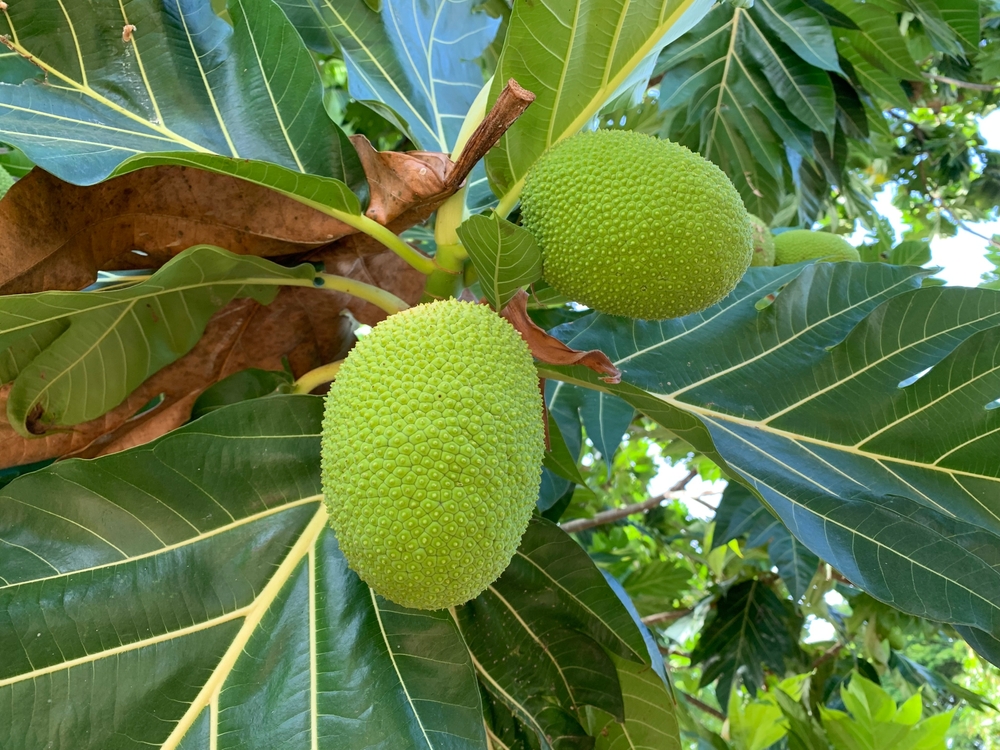Introduction to Breadfruit
Understanding Breadfruit’s Global Culinary Significance
Breadfruit, with its scientific name Artocarpus altilis, is a remarkable fruit that has captivated the taste buds of people across the globe. This multipurpose tree is natively grown in the Pacific Islands and is a staple food in many tropical regions. Not only does it play an essential role in tropical agriculture, but it also holds a place of importance in cultural traditions and feasts. The beauty of breadfruit lies in its adaptability; it can be used in countless culinary applications, transcending cultural and geographical barriers. From savory stews to sweet desserts, breadfruit’s versatility has led to its integration into various cuisines. Its significant nutritional value, coupled with its plethora of uses makes breadfruit a noteworthy ingredient in the global kitchen, facilitating nurturing connections among diverse food cultures and contributing to the sustainability of food systems worldwide.
The Nutritional Profile of Breadfruit
Exploring the Health Benefits of this Tropical Fruit
Breadfruit is not just a culinary delight; it’s a powerhouse of nutrition, making it an excellent addition to a health-conscious diet. This starchy fruit contains many complex carbohydrates, released slowly into the bloodstream, offering a sustained energy source. It’s also an incredible source of dietary fiber, aiding digestive health and promoting a feeling of fullness. Notably, breadfruit features a range of vitamins and minerals, including vitamin C, potassium, and specific B vitamins. Its richness in antioxidants helps to combat oxidative stress and inflammation in the body, potentially reducing the risk of chronic diseases. By including breadfruit in one’s diet, individuals can benefit from its nutrient density and contribute to maintaining their overall health and well-being.

Culinary Versatility of Breadfruit
Various Ways to Cook and Enjoy Breadfruit
Breadfruit stands out for its impressive culinary adaptability. Its neutral taste and potato-like texture make it an excellent substitute for many carbohydrate-rich foods, such as potatoes, rice, or pasta. Breadfruit can be roasted, boiled, fried, or steamed to create many dishes catering to all types of palates. For a simple yet satisfying meal, roasted breadfruit with a sprinkle of salt serves as a delicious snack or side dish. Alternatively, it can replace mashed potatoes as a healthier option with an exotic twist when boiled and mashed. Breadfruit flour is another innovative product; it’s gluten-free, making it ideal for those with gluten sensitivities or who prefer gluten-free diets. The flour can be used for baking bread, cakes, or for thickening soups and sauces. With so many cooking methods available, there’s an endless possibility of exploring recipes with breadfruit as the star ingredient.
Breadfruit in Traditional and Modern Dishes
Rooted in tradition, breadfruit has been a fundamental component of many indigenous recipes and continues to inspire modern culinary creations. In traditional Pacific Island cuisine, breadfruit is often cooked in an underground oven called an “umu” and served with coconut cream. In the Caribbean, breadfruit is essential in traditional dishes such as “oil down,” a one-pot stew with breadfruit, salted meat, and coconut milk. As contemporary chefs embrace this versatile fruit, breadfruit is entering modern gastronomy. It’s being reimagined in dishes such as breadfruit tacos, vegan breadfruit burgers, and even as a base for gluten-free pizzas. The adaptability of breadfruit ensures that it can fit seamlessly into both time-honored recipes and innovative contemporary menus, proving its worth as a culinary staple from past to present.
Preparing Breadfruit in Your Kitchen
Tips for Selecting, Storing, and Preparing Breadfruit
For those new to breadfruit, understanding how to select, store, and prepare this fruit can make all the difference in cooking. When selecting breadfruit, look for firm, mature fruits with green to yellowish skin; a sweet fragrance indicates ripeness. Once at home, store unripe breadfruit at room temperature until it matures. It can be refrigerated upon ripening to slow down the process, prolonging its shelf-life. When preparing breadfruit, it’s essential to cut out the core and remove the skin. The fruit can then be sliced or cubed, depending on the recipe. Before cooking, it is recommended to soak the flesh in water to prevent discoloration. Getting familiar with these basic tips will make breadfruit an easy and enjoyable addition to any kitchen repertoire, letting the fruit’s unique flavor and texture shine in various culinary applications.
Simple and Delicious Breadfruit Recipes
For home cooks looking to introduce the delights of breadfruit to their tables, there are numerous simple recipes to start with. A classic breadfruit recipe is to dice the fruit and pan-fry it with aromatic herbs and spices until golden and crispy, serving it as a hearty side dish. Another easy option is a creamy breadfruit soup, which showcases breadfruit’s ability to create a rich and velvety texture. Breadfruit chips are a healthier alternative to traditional potato chips, made by thinly slicing the fruit and baking or frying until crunchy. A breadfruit salad with a tangy dressing, tossed with fresh vegetables and herbs, can also be a refreshing way to enjoy this fruit. These recipes underline how effortlessly breadfruit can be incorporated into everyday meals, offering various flavors and textures to savor.

Breadfruit in Different Cultural Cuisines
How Different Cultures Incorporate Breadfruit into Their Diet
Breadfruit has been embraced by a variety of cultural cuisines around the world, each incorporating it in unique and flavorful ways. In the Pacific Islands, breadfruit is often baked with coconut milk, creating a hearty and sweet dish. The Caribbean islands use breadfruit in savory applications, such as “breadfruit cou-cou,” where it is mixed with okra and served alongside flying fish. In Sri Lanka, breadfruit curry is a popular dish that features breadfruit cooked with spices and coconut milk. In parts of Africa, it’s used similarly to plantains—to accompany meat stews or as a standalone snack when fried. These cultural interpretations of breadfruit highlight its global significance and the shared appreciation for its versatility and taste among diverse populations.
Sustainability Aspects of Breadfruit
Breadfruit’s Role in Sustainable Agriculture and Food Security
Breadfruit is increasingly recognized for its potential contribution to sustainable agriculture and food security. The breadfruit tree is a low-maintenance crop that requires minimal care once established, making it an environmentally friendly choice for farmers. It provides a fruitful yield year-round, which can be a reliable food source to combat hunger in tropical regions. Being a perennial crop, it helps maintain soil health and reduces the need for land clearing, which is a common issue with annual crops. With the ability to thrive in various soil types and conditions, breadfruit is a boon for regions facing climate change-related challenges. Efforts to cultivate breadfruit as a sustainable alternative to traditional staple crops can play a vital role in building resilient food systems and ensuring food security for many communities worldwide.
Innovations and Future Trends in Breadfruit Usage
New Culinary Creations and Uses for Breadfruit
As public interest in sustainable and nutritious food grows, breadfruit sparks culinary innovation and inspires new trends. Among these is the development of breadfruit flour, which has emerged as a gluten-free, fiber-rich alternative for baking and cooking. Plant-based diets also drive the exploration of breadfruit as a meat alternative, given its satisfying texture and ability to absorb flavors. Food technologists and chefs are experimenting with breadfruit in snack production, such as bars and granola, tapping into the health food market. Due to its starch content, there’s also a growing movement to utilize breadfruit in ways that extend beyond the kitchen, such as in animal feed or even biodegradable packaging materials. The future of breadfruit usage looks promising, with its versatility lending itself to numerous applications that could positively impact both gastronomy and the environment.
FAQs About Breadfruit in Cooking
Do You Have to Cook Breadfruit Before Eating?
Yes, breadfruit should be cooked before consumption. Unlike some fruits that are eaten raw, breadfruit has a hard, starchy flesh that is not suitable for eating uncooked. When cooked, the texture softens considerably and the subtle flavors are enhanced, making it versatile and enjoyable in various dishes. There are numerous ways to prepare breadfruit, including roasting, boiling, or frying, each method bringing its unique taste and texture to the forefront. Consequently, always consider cooking breadfruit to experience its full culinary potential.
How Can You Tell When Breadfruit Is Ripe and Ready to Cook?
Identifying ripe breadfruit is key to enjoying its best flavor and texture. When pressed, a ripe breadfruit will have a gentle give, indicating its flesh is softening. The skin color may turn from a bright green to a more yellowish hue, and brown patches may also develop. Additionally, a ripe breadfruit will emit a pleasant, sweet fragrance. If plucked before it’s fully mature, it can be left at room temperature to ripen. While ripe breadfruit is excellent for most dishes, slightly underripe breadfruit is sometimes preferable for dishes requiring firmer textures.
What Are the Best Ways to Preserve Breadfruit?
Preserving breadfruit is quite straightforward and helpful for extending its shelf life, making it available for later use. One common method is refrigeration, which is ideal for keeping ripe breadfruit for a few days. For long-term preservation, breadfruit can be frozen; to do so, first remove the skin and core, then cut the breadfruit into slices or chunks and freeze them in airtight containers or freezer bags. Additionally, breadfruit can be dried or turned into flour, which is excellent for baking and has a longer shelf life. It’s important to note that these preservation methods may alter the fruit’s texture or flavor slightly, but breadfruit will still be quite usable in various recipes.
What Foods Pair Well with Breadfruit Dishes?
Breadfruit’s mild, starchy profile makes it a highly versatile food that pairs well with a multitude of flavors. Its texture complements rich, hearty foods like curries, stews, and braised meats. Breadfruit also goes well with fresh, green vegetables like spinach, kale, and bell peppers, offering a pleasant contrast. Seafood is another excellent pairing; in the Caribbean, breadfruit is often accompanied by saltfish or other ocean fare. Spices, sauces, and seasonings easily enhance its subtle taste, so incorporating ingredients like garlic, coconut milk, or curry spices can elevate a breadfruit dish. Ultimately, the versatile character of breadfruit allows it to fit seamlessly into a wide range of culinary contexts.
Dive into the world of Oceania’s culinary heritage by exploring indigenous ingredients in Oceania. Unearth flavors you’ve never imagined!
